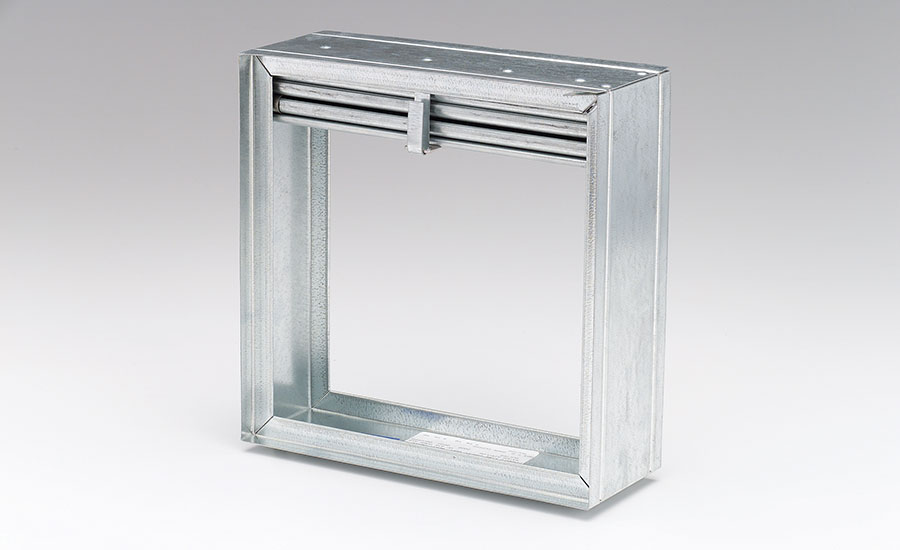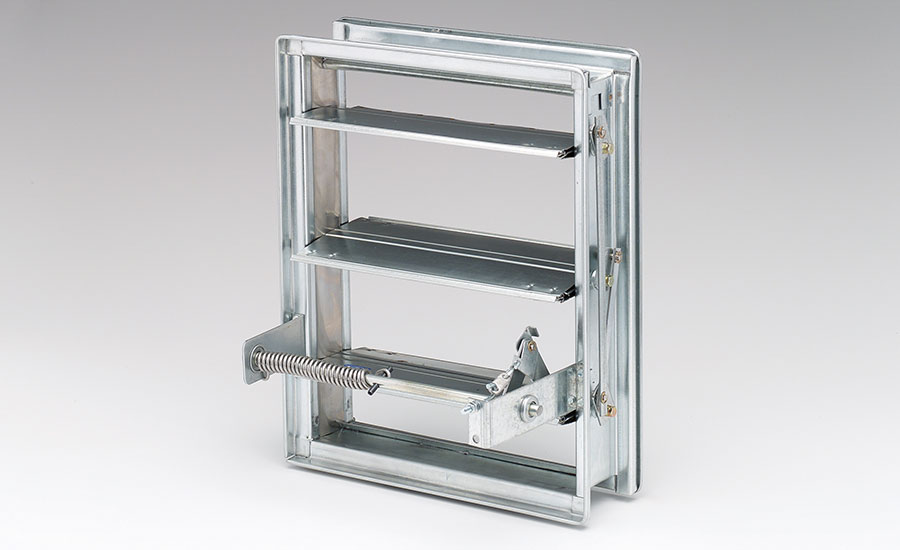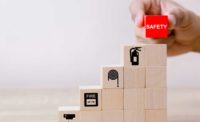Whether it be a single building or a campus in a university, corporation/healthcare complex, there is a common requirement when it comes to life safety dampers. That common requirement is the proper installation, operation, and maintenance that is validated by required inspection and testing from the beginning to the end of the life safety damper life.
Liability is a word that most in the HVAC industry don’t like to think about too much, yet it is integral to the industry for engineers, architects, contractors, and building owners, too. When it comes to life safety dampers, liability of installation, operation, and maintenance is a reality that should be discussed more than it is. Although code officials, the Authority Having Jurisdiction (AHJ), may think they don’t have liability, they do if they direct others to do things in conflict with code and manufacturers’ requirements for the proper installation, maintenance, and operation of life safety dampers.
In addition to being required (and being the right thing to do), the proper installation, inspection, testing, and maintenance of life safety dampers is a good business opportunity for many facility engineering firms or service contractors. Many rural areas may not have qualified companies or people, so a team that travels to remote areas may indeed be worth considering when building insurance companies begin to focus on this as a requirement to maintain property loss coverage.
UL-Listed IOM Requirements
IOM’s are available for specific products by each manufacturer of all types of life safety dampers including curtain type fire dampers as show in Figure 1 and multi-blade type fire dampers as shown in Figure 2. Each manufacturer has their life safety dampers tested and provide IOMs for proper installation, operation, a maintenance. This is documented specifically for each life safety product and needs to be adhered to by the engineer, contractor, AHJ, and building owner.
 FIGURE 1. Curtain type fire damper (Photo courtesy of Ruskin).
FIGURE 1. Curtain type fire damper (Photo courtesy of Ruskin).
Design and Installation Considerations
When an engineer designs the HVAC system, one of the most critical coordination issues with the architect is understanding where all the rated walls and assemblies are, so that the proper life safety damper products can be incorporated into the HVAC system design. Access to each and every life safety damper is essential for all the testing and inspections required throughout the life of the product. Proper access takes coordination with all other disciplines during design and all the trades during construction to ensure this design intent is executed. The accessibility should be discussed during design with the entire team, including the facility owner and manager.
The access needs to be unobstructed and large enough to permit inspection and maintenance, but it must not affect the integrity of fire resistance-rated assemblies. The access points need to be permanently identified on the exterior by a label with letters usually not less than .5-in height or as required by the project requirements and current codes. In addition, the damper type and location should be called out on the drawing of the HVAC system. It is also helpful if every life safety damper is uniquely labeled on the plans and scheduled on the contract document drawings using the same labeling system that will be put on the access location.
Operation Considerations
Operation of a life safety damper is sometimes just assumed to be a part of the process, with little thought to what it really takes to ensure the product can indeed operate when it is called to do so. It is wise for the entire team to read and discuss the life safety damper IOMs during design and review how and when each damper will be activated.
Maintenance Considerations
Maintenance of a life safety damper begins during the design phase of a project and includes not only the engineer but, just as importantly, the architect. The architect must not only be sensitive to the maintenance access to life safety dampers but also the assemblies specified for walls, floors, ceilings, roofs, and shafts that will affect the types of life safety dampers required.
Maintainability is where the liability rubber hits the road. If a product is not maintainable for any reason, the engineer, architect, contractor, and even the AHJ have liability. Maintainability begins with the product design and proper accessibility.
If a damper is found to not be working, then repairs should be done as soon as possible. Minor adjustment may be performed in the field in accordance with UL guidelines and manufacturer’s UL instructions. It is the responsibility of the authority having jurisdiction (AHJ) to determine the acceptability of the modification.
In general, fuse links are not required to be replaced when testing, but if the link is damaged or painted, it should be replaced. The links should be replaced with the same size, temperature, and load rating.
Codes and Standards
Compliance with codes and standards is the minimum requirement for any HVAC system design and installation and maintenance. Codes and standards that are applicable include, but may not be limited to depending on project location, the International Building Code (IBC), Underwriters Laboratory (UL), National Fire Protection Association (NFPA) 4, 72, 80, 90A, 92, and 105. Most of the information contained in this article is information that can be found in these and other industry documents.
Inspection and Testing
Testing of life safety dampers has been in the codes and standards for years; however, many times the full extent of the testing required by codes, standards, and even the manufacturer’s own IOM requirements have been ignored and maybe still are. It is a huge risk and liability on the part of the architect, engineer, contractor, and the owner to also ignore testing requirements. One of the biggest risks beyond the damper not working when required is that the building insurance company could indeed possibly refuse to cover the loss of property or even loss of life in a litigation case if the dampers were not properly installed, tested, and maintained.
Each damper should be inspected and tested by a company and person thoroughly knowledgeable of the specific system operation and testing and maintenance requirements of the specific products installed. The impact on the product components, system, and building occupants should be evaluated before testing by qualified personnel.
It is possible and generally acceptable that the inspection and testing be done by internal facility maintenance staff who are qualified to do so. However, if an outside company is hired, here are a few things (but not necessarily the only things) to consider when choosing an outside company.
- Does the company have a good reputation and experience for this type of work?
- Is the company insured and bonded?
- Is there a training and certification of the people doing the work?
- Does the company have a list of past projects with reference listings from past clients?
- Does the company provide written and digital documentation as part of the service?
- Does the company have any type of quality assurance program to audit the work?
- What are the terms of the contract for the service and are there clauses that hold them harmless if they fail to do their due diligence?
Operational testing of each individual system component should be performed. The testing should include all subsystems to the extent that they impact or are impacted by the operation of the life safety system. This includes all fire, smoke, combination fire smoke, and ceiling radiation dampers and their installed components (fuse links, limit switches, smoke detectors, etc.) as applicable. All indicating devices need to be verified to work and reporting to the intended location. Each operational test should be conducted under a non-fire HVAC airflow condition. Judgement should be made as to whether dynamic dampers are tested under static or dynamic air flow conditions.
The main question then becomes, “when should life safety dampers be tested?” There are three times that must be adhered to.
 FIGURE 2. Multi-blade fire damper (Photo courtesy of Ruskin).
FIGURE 2. Multi-blade fire damper (Photo courtesy of Ruskin).
The first test and inspection is when each damper is tested after it is installed. This test is to verify that the damper is installed correctly and there are no obstructions keeping the damper from opening and closing as required. Each and every damper should be operated and tested prior to the building occupancy. If a smoke detector is installed it needs to be tested, as well as any other indicating devices and accessories.
The new 2019 edition of NFPA 80 actually removes the requirement for visual inspection after this initial test leaving open the option to use test switches and remote testing options that are available from life safety damper manufacturers.
The second test and inspection of each damper is one year after installation. This test is to verify that the damper has no interference due to such things as rusted, bent, misaligned, or damaged parts during the construction phase of the building or debris that may have somehow lodged in the damper that would prevent proper operation. The dynamic dampers need to be tested under normal operation conditions, and care should be taken not to collapse the duct. This can be challenging but is important to do.
The third and ongoing time that each damper should be tested and inspected is every four years after the one-year inspection. Hospitals may be tested and inspected up to six-year intervals. Hospitals are the only I-2 occupancy that is not tested every four years. All other I-2 occupancy require testing every four years and/or smoke and combination fire/smoke dampers for dedicated and non-dedicated smoke control system such that for dedicated system — semiannually and non-dedicated system — annually.
As shown in the photos in Figure 3, curtain type dampers can be difficult or even impossible to test if access is not designed into the system. This becomes a liability issue for the engineers, architects, and contractors that don’t pay attention to accessibility of life safety dampers. The practicality of trying to reach in a duct to test and reset a curtain type fire damper through a duct access panel with two hands needs to be taken into consideration. Trip the curtain-type fire damper, then inspect closure, then lift the damper back into place and install fuselink.
Manufacturers’ options of manual levers on multi-blade fire dampers in lieu of curtain-type fire dampers or the use of test switches may be more user-friendly for the facility owner and contractor.
Records
All inspections, testing, and maintenance should be documented for each life safety damper. Many larger facilities and multi-building campuses have computerized and automated predictive maintenance programs that are used to ensure proper record keeping is done for both insurance and other jurisdictional requirements. Facility managers who understand the importance and liability of proper life safety damper inspections, testing, and maintenance clearly know the importance of documentation.
As a guideline, the documentation should include but not necessarily be limited to:
- The damper location
- The type of damper (fire, smoke, combination fire/smoke and ceiling radiation damper, etc.)
- Date of inspection
- Name of company doing the inspection and testing
- Person or persons that are inspecting and testing
- Description of the damper condition
- Description of each deficiency or discovery of improper condition
In addition to the documentation noted above, the documentation should include space for when maintenance was performed, how each deficiency was fixed, date when the deficiency was fixed, and the person or persons that fixed the deficiencies. The documentation should be provided to the owner and available for review by the AHJ and maybe even the building property loss insurance company.
Commissioning
There is no doubt that commissioning of life safety dampers is as critical to the IOM process as with any component of an HVAC system. The requirements for inspecting and testing of life safety dampers at three different distinct timeframes along with the ongoing testing over the life of the damper certainly fall into the realm of a commissioning process. The codes, standards, and manufacturer’s IOM requirements make commissioning a process that is not optional with regard to testing to ensure proper operation even if other parts of the HVAC system are not commissioned for reasons of reduced cost.
 FIGURE 3. Manual resetting of curtain type fire damper after testing (Photos courtesy of Ruskin).
FIGURE 3. Manual resetting of curtain type fire damper after testing (Photos courtesy of Ruskin).
Resources
A few of the websites that may be of help in gaining greater understanding of the topic of life safety damper inspection and testing are www.ul.com, www.nfpa.com, and www.iccsafe.org, as well as other code body websites. In addition, consider AMCA Guide for Commissioning and Periodic Performance Testing of Fire, Smoke and Other Life Safety Related Dampers (PDF at www.amca.org). In addition, each manufacturer of life safety dampers can provide specific information on their specific dampers that may be installed in a building and can be contacted through a local manufacturers’ rep agency or through their website to get information about the product and replacement parts if needed.
Conclusions
Life safety dampers indeed are one of the most important products in an HVAC system. Proper installation, operation, and maintenance must be a priority of the entire building team, including the architect, engineer, contractors, and especially the owner, along with the Authority Having Jurisdiction from permitting through the end of the installation inspection process.
Getting this aspect of design and installation right is essential for minimizing liability for all involved, and it is simply the right thing to do, no matter what the cost. Putting a price on life safety damper IOM is not something any facility owner should attempt to do when hiring the professionals who design and build the buildings, especially when the codes require proper procedures.





